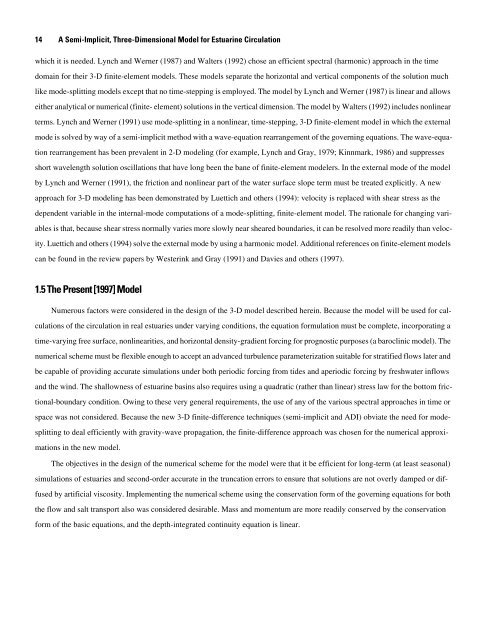A Semi-Implicit, Three-Dimensional Model for Estuarine ... - USGS
A Semi-Implicit, Three-Dimensional Model for Estuarine ... - USGS
A Semi-Implicit, Three-Dimensional Model for Estuarine ... - USGS
Create successful ePaper yourself
Turn your PDF publications into a flip-book with our unique Google optimized e-Paper software.
14 A <strong>Semi</strong>-<strong>Implicit</strong>, <strong>Three</strong>-<strong>Dimensional</strong> <strong>Model</strong> <strong>for</strong> <strong>Estuarine</strong> Circulation<br />
which it is needed. Lynch and Werner (1987) and Walters (1992) chose an efficient spectral (harmonic) approach in the time<br />
domain <strong>for</strong> their 3-D finite-element models. These models separate the horizontal and vertical components of the solution much<br />
like mode-splitting models except that no time-stepping is employed. The model by Lynch and Werner (1987) is linear and allows<br />
either analytical or numerical (finite- element) solutions in the vertical dimension. The model by Walters (1992) includes nonlinear<br />
terms. Lynch and Werner (1991) use mode-splitting in a nonlinear, time-stepping, 3-D finite-element model in which the external<br />
mode is solved by way of a semi-implicit method with a wave-equation rearrangement of the governing equations. The wave-equa-<br />
tion rearrangement has been prevalent in 2-D modeling (<strong>for</strong> example, Lynch and Gray, 1979; Kinnmark, 1986) and suppresses<br />
short wavelength solution oscillations that have long been the bane of finite-element modelers. In the external mode of the model<br />
by Lynch and Werner (1991), the friction and nonlinear part of the water surface slope term must be treated explicitly. A new<br />
approach <strong>for</strong> 3-D modeling has been demonstrated by Luettich and others (1994): velocity is replaced with shear stress as the<br />
dependent variable in the internal-mode computations of a mode-splitting, finite-element model. The rationale <strong>for</strong> changing vari-<br />
ables is that, because shear stress normally varies more slowly near sheared boundaries, it can be resolved more readily than veloc-<br />
ity. Luettich and others (1994) solve the external mode by using a harmonic model. Additional references on finite-element models<br />
can be found in the review papers by Westerink and Gray (1991) and Davies and others (1997).<br />
1.5 The Present [1997] <strong>Model</strong><br />
Numerous factors were considered in the design of the 3-D model described herein. Because the model will be used <strong>for</strong> cal-<br />
culations of the circulation in real estuaries under varying conditions, the equation <strong>for</strong>mulation must be complete, incorporating a<br />
time-varying free surface, nonlinearities, and horizontal density-gradient <strong>for</strong>cing <strong>for</strong> prognostic purposes (a baroclinic model). The<br />
numerical scheme must be flexible enough to accept an advanced turbulence parameterization suitable <strong>for</strong> stratified flows later and<br />
be capable of providing accurate simulations under both periodic <strong>for</strong>cing from tides and aperiodic <strong>for</strong>cing by freshwater inflows<br />
and the wind. The shallowness of estuarine basins also requires using a quadratic (rather than linear) stress law <strong>for</strong> the bottom fric-<br />
tional-boundary condition. Owing to these very general requirements, the use of any of the various spectral approaches in time or<br />
space was not considered. Because the new 3-D finite-difference techniques (semi-implicit and ADI) obviate the need <strong>for</strong> mode-<br />
splitting to deal efficiently with gravity-wave propagation, the finite-difference approach was chosen <strong>for</strong> the numerical approxi-<br />
mations in the new model.<br />
The objectives in the design of the numerical scheme <strong>for</strong> the model were that it be efficient <strong>for</strong> long-term (at least seasonal)<br />
simulations of estuaries and second-order accurate in the truncation errors to ensure that solutions are not overly damped or dif-<br />
fused by artificial viscosity. Implementing the numerical scheme using the conservation <strong>for</strong>m of the governing equations <strong>for</strong> both<br />
the flow and salt transport also was considered desirable. Mass and momentum are more readily conserved by the conservation<br />
<strong>for</strong>m of the basic equations, and the depth-integrated continuity equation is linear.

















